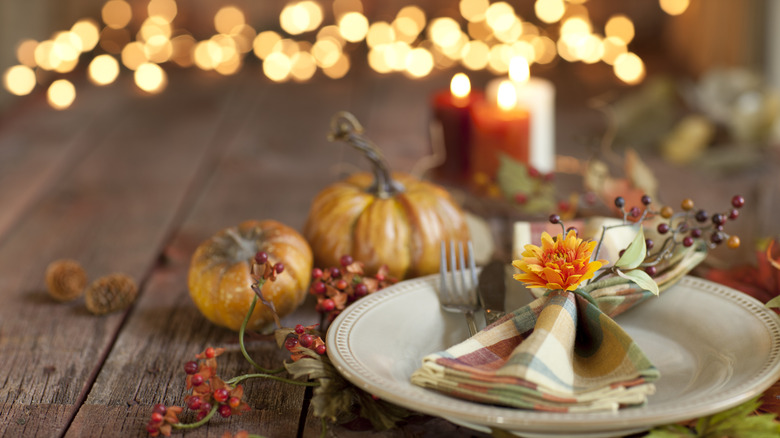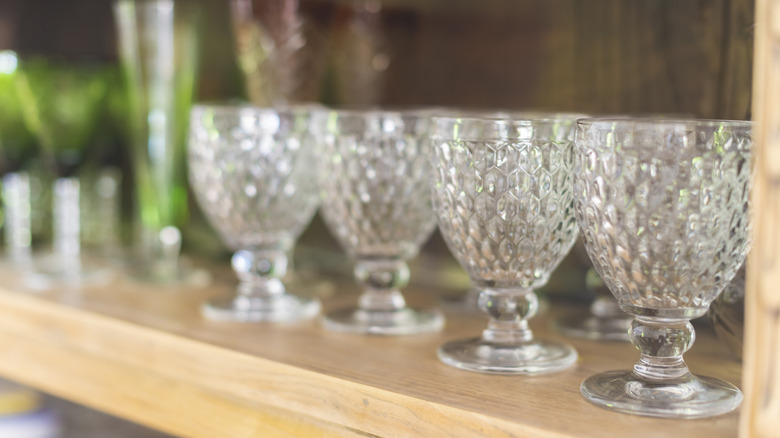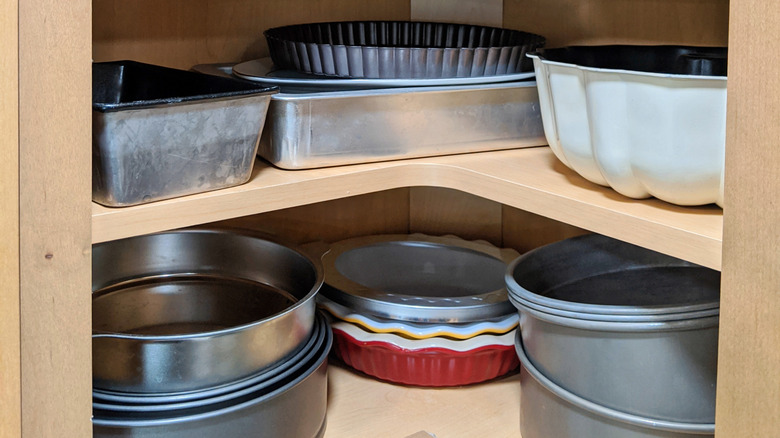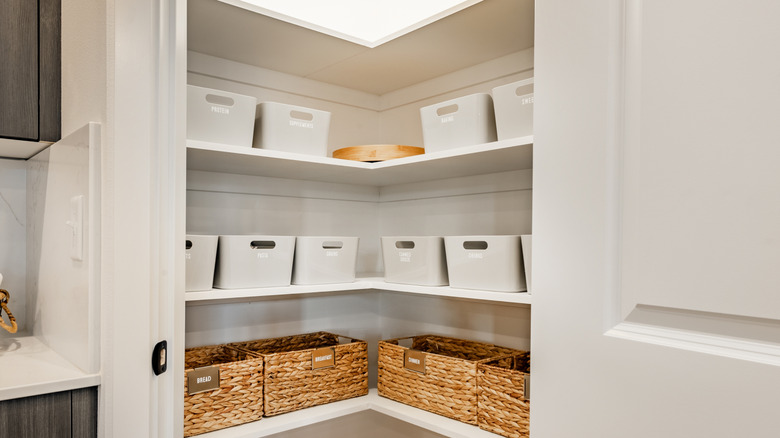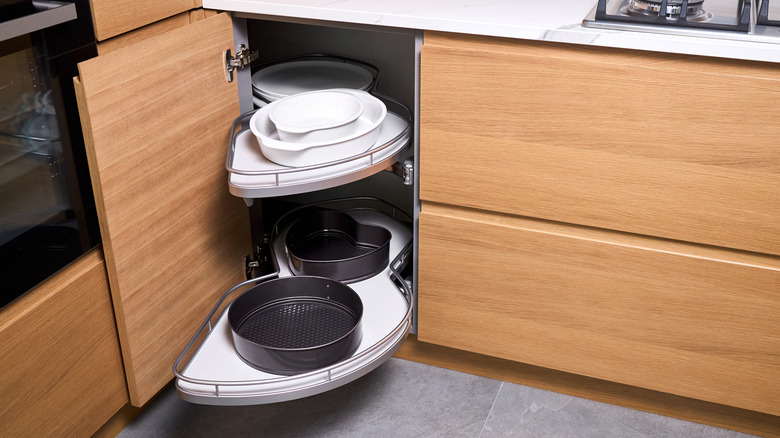7 Ways To Make The Most Out Of Those Hard-To-Reach Kitchen Cabinets
We may receive a commission on purchases made from links.
Do you love organization and efficiency? If so, you understand the desire to maximize every corner of your kitchen, including those hard-to-reach cabinets. You know the cupboards we're talking about: High up, extra deep, or in awkward corners. Although many people let this precious space go to waste, you can utilize these areas effectively. You just need the right hacks!
For starters, you'll want to get a folding step ladder. You can organize cabinets to perfection, but if you can't reach them, what's the point? The goal is for everything to be easily accessible, and if you need to cheat a little in the height department, so be it. Now, you can grab and return items to high cupboards without worrying about breakage. So, if you've been ignoring these cupboards, get ready to start using them!
Kitchen storage also needs to be strategic. Keep items you use daily within arm's reach. Lesser used items can be placed in these harder-to-reach cupboards. If you're having trouble drawing the line between frequent and infrequent use, we've got you covered. We'll break down exactly what to store where and how to keep track of it all.
Store seasonal kitchen items
Hard-to-reach cabinets are the perfect place to store kitchenware you use seasonally. Think holiday decor, birthday supplies, and seasonal plates. This can include everything from themed tablecloths and napkins to festive dishes and vases. Meanwhile, seasonal kitchenware can be on rotation. Keep it accessible when in use and store it in the off-season. As summertime approaches, you can swap that slow cooker or turkey baster for grilling gear and the ice cream maker.
Where you store seasonal kitchen items depends on their size and shape. High cabinets are better for lightweight or fragile items like table settings, centerpieces, and vases. Meanwhile, heavy seasonal appliances like beverage dispensers and crock pots can be kept in lower, deeper cupboards. If you have smaller pieces, such as holiday cookie cutters, place them together in a plastic bin with labels.
Since you only need to use these items a few times a year, accessing them won't feel like a huge hassle. And if it's the turn of seasons, it could even feel like a right of passage. After pulling out that step ladder and gathering supplies, you can decorate the kitchen to reflect the time of year. It pays to reorganize your kitchen every few months anyway, so use this moment as an excuse!
Keep fragile glassware and vases in high cupboards
Want to keep fragile glassware safe? Keep it up high. The less access people have to it, the less likely they are to knock it over. Plus, it'll be out of reach of young kids. Chances are, you rarely use these delicate pieces, so you don't need them to be at eye level. If gifted flowers, you can use a step ladder to peruse and choose your desired vase. When hosting a special occasion, simply pull down the fancy glassware and replace it after washing.
High cabinets create an ideal environment for storing delicate glassware and vases. The enclosed space protects it from dust and temperature fluctuations. Plus, some top cabinets come with glass doors, allowing you to showcase your beautiful collection. To keep your glassware even safer, line the shelves with non-slip mats and leave space between items to prevent them from clinking together. For the best visibility, place taller items towards the back so you can view everything.
House long and large equipment in deep cupboards
We all have a collection of those awkward kitchen items — ones that are large and thin or super bulky. Think serving platters, extra cutting boards, and large salad bowls. We never quite know where to put them since they take up significant space, and don't fit neatly anywhere. The solution? Those hard-to-reach deep cupboards!
The benefit of deep cupboards is they can fit long and large items. The downside? Those items can easily get lost in the shuffle, pushed to dark depths, never to be found again. So to utilize the space effectively, you need to be strategic. Scan your kitchen to see what types of deep cupboards you have. Those that are tall and narrow are ideal for thin kitchenware with a lot of surface area. This includes baking trays, cutting boards, and serving platters. By organizing these items vertically in this space, you'll be able to see and access them more easily. Wide and deep cabinets or corners are better suited for bulky items like kitchen appliances and large pots and pans. Lastly, keep lightweight items up high and heavier items down low for obvious gravity reasons.
Store infrequently used cookware, appliances, and cookbooks
Hard-to-reach cabinets are a great place to store spillover items — the stuff you don't want to part with but don't use frequently. Perhaps you have duplicate appliances that will eventually replace your current items; a bread maker or juicer you use occasionally but can't justify keeping on the counter; or a collection of cookbooks with sentimental value. You don't need to jettison these items — you just need an appropriate place to store them.
Like all kitchenware, consider the weight and size before shoving it in a cabinet. Heavy pots and pans belong in low, deep cupboards while lightweight items can go up high. But when it comes to cookbooks, you don't need to hide them inside the kitchen cabinets at all. Since they have an aesthetic appeal, arrange them on top of the cabinets. Not only will you remember which books you own, but displaying books contributes to that cozy feeling — or as Scandinavians would say, hygge.
Organize items in bins
It can be tricky pulling things out of deep or tall cabinets. Smaller items can get stuck in the back and the next thing you know, you're fishing around blindly for it. To avoid this, place smaller items in bins. This strategy works well for everything from collections of teacups to cookie cutters.
Mind you, not all bins were created equal. If these bins are kept near food products, we recommend avoiding wicker storage containers since they attract insects by offering a natural nesting ground. Instead, we suggest plastic, glass, or metal. Plastic works best for high cabinets since it's lightweight, allowing you to lower bins without fear of breakage. Clear bins also have an advantage since you can see the contents without having to reach them. We also recommend getting bins with handles for easy maneuvering.
If your cabinets or shelving is exposed and you prefer the streamlined look, opt for neutral-colored or wooden containers. However, add labels so you know what's inside. Finally, if you also want to utilize the space above kitchen cabinets, opt for metal canisters and fill them with infrequently used dry goods. Think pantry staples that are well-sealed and don't need to be accessed often like extra sugar, rice, or pasta.
Use a lazy Susan and shelf extensions
Have you ever gotten down on your hands and knees searching for something in the back of that cupboard? Before you go digging around, we have a better suggestion: Cabinet extensions. These handy tools help you access items on the opposite side of the cabinet without overextending your arms.
There are several types of extensions, each with pros and cons. Lazy Susans work well for storing smaller items like spices. If your cabinet is tall enough, we recommend getting a two-tiered lazy Susan to maximize space. On Amazon, you can purchase this double-tiered turntable organizer, which has a 12-inch diameter and comes in a stylish rustic brown.
Pullout shelving is exactly as it sounds; it allows each shelf to extend independently. Rather than reach into the back of the cupboard, the cupboard can come to you! This works particularly well in lower and deep cabinets. For corner cabinets, magic spinout shelving works best. The rotating mechanism brings items from the back to the outside of the cabinet, preventing equipment from getting blocked or piled over.
Label the cabinets
It's easy to forget what you own when it's stored in hard-to-reach cabinets. You know you have holiday decor up there, but every time you look, it's like a mini Christmas. You begin unveiling forgotten tablecloths, centerpieces, or candles. However, this process can be time-consuming. And without knowing what you already have, you may end up buying duplicates and contributing to waste. Luckily, the solution is simple: Label your cabinets.
Labeling is a crucial part of an expert-recommended system for organizing your pantry. There are two ways you could go about labeling: On storage bins or on the cupboard itself. If using storage bins, we recommend labeling directly on those. If you rearrange your cupboards, you won't have to rearrange the labels — they'll be firmly planted where they belong.
When labeling cabinets, we suggest sticking a list of contents on the inside of the door. You can write labels directly on masking tape or a sticky note. You could also use a color-coded system to identify holidays or certain kitchenware. However, for a long-lasting, more accessible option, we suggest a laminated detachable list. Since these cabinets are hard to reach, you can grab and read the full list before diving in.

